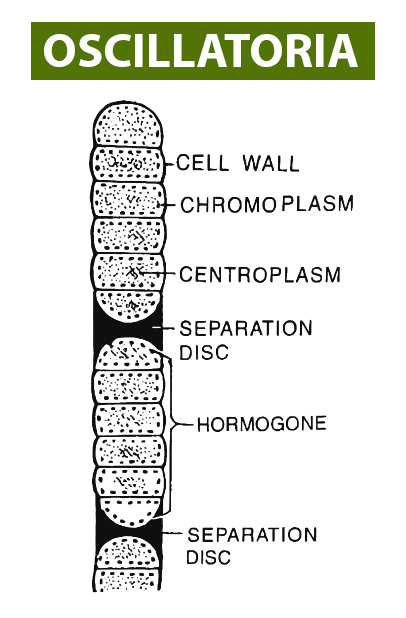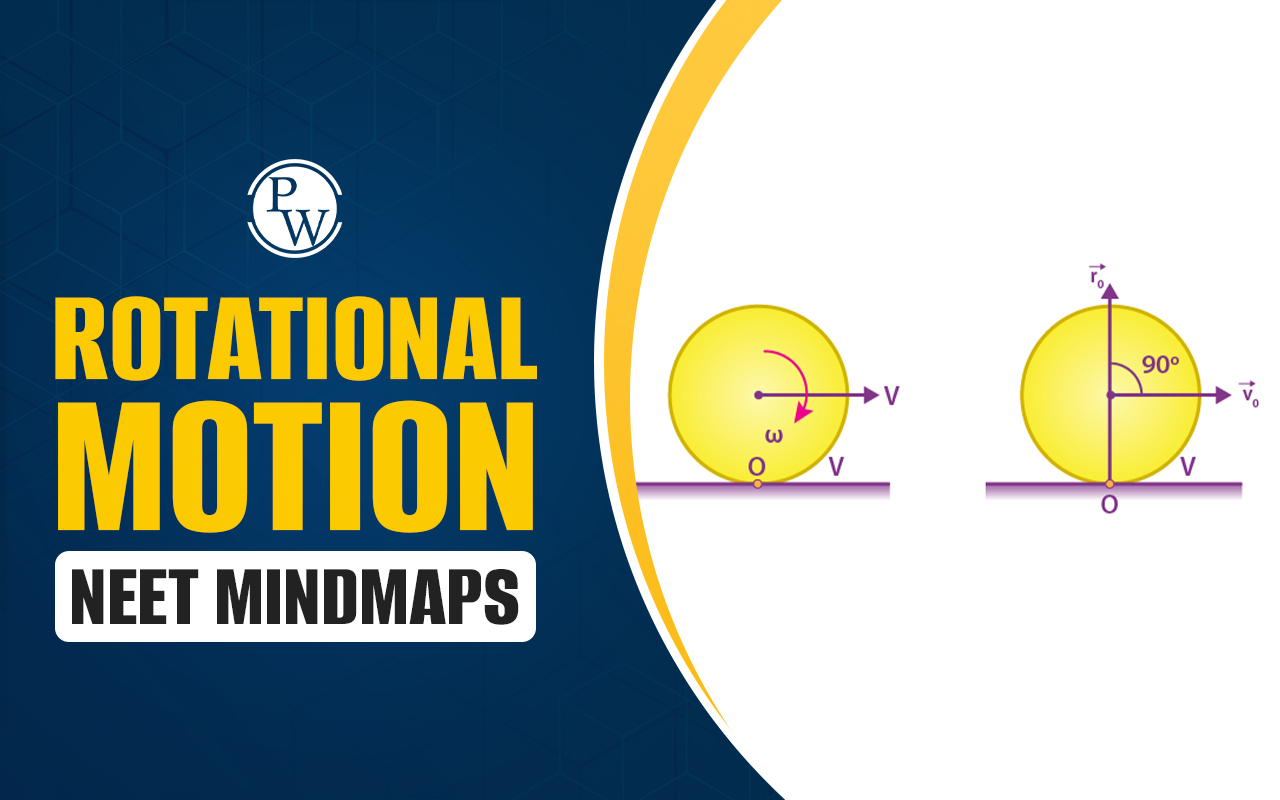

Oscillatoria: Oscillatoria is a genus of filamentous cyanobacteria, commonly known as blue-green algae, found in freshwater habitats. It forms thin, bluish-green coatings on surfaces. Each filament, or thallus, is unbranched and composed of cells arranged in a single row, covered in a gelatinous sheath.
Oscillatoria colonies can be interconnected or free-floating, forming dense masses or loose sheets. Each cell contains protoplasm divided into colorless centroplasm and pigmented chromoplasm, with dispersed thylakoids, gas vacuoles, and photosynthetic pigments.
The cells lack membrane-bound organelles but contain ribosomes and reserve food materials. The nuclear material, forming a nucleoid, consists of irregularly arranged DNA fibrils without an outer nuclear membrane. Reproduction occurs vegetatively through fragmentation and hormogone formation. NEET Biology Notes on Oscillatoria is provided in the article below.
What is an Oscillatoria?
Oscillatoria is a blue-green filamentous algae growing widely in North Carolina. These algae produce moving filaments that intertwine to form thin mats that cover sediment and other submerged areas. These mats often appear bright blue or blue-green, resembling spilled paint.
Over time, as the mats mature and become thicker, clumps break away and rise to the water's surface. During the day, these clumps rise as algae perform photosynthesis and emit oxygen. However, the clumps sink back down to the bottom when oxygen levels decrease at night.
Sexual Reproduction in Flowering Plants
Oscillatoria Diagram
The oscillatoria diagram is as follows:

Oscillatoria Classification
Oscillatoria species inhabit both freshwater and marine environments. They are notable for forming blooms, which can cause water discoloration and produce toxins. Some Oscillatoria species can fix nitrogen, an essential nutrient for plants. Oscillatoria belongs to the group of filamentous cyanobacteria, previously known as blue-green algae. The following is a classification of oscillatoria:
| Oscillatoria Classification | |
| Taxonomic Rank | Category |
| Kingdom | Bacteria |
| Subkingdom | Negibacteria |
| Phylum | Cyanobacteria |
| Class | Cyanophyceae |
| Order | Oscillatoriales |
| Family | Oscillatoriaceae |
| Genus | Oscillatoria |
Structural Organisation in Animals
Oscillatoria Structure
Oscillatoria is a type of filamentous cyanobacteria that forms long chains or filaments of cylindrical cells. The following is the detailed structure of Oscillatoria.
1. Thallus: The body of Oscillatoria, known as a thallus, consists of a single unbranched thread. It is composed of a row of cells that develop into unbranched filaments covered with a gelatinous coating. Oscillatoria is usually found in interconnected masses or free-floating colonies, often forming dense tangles or spongy sheets.
2. Trichomes: The unbranched filaments of Oscillatoria are called trichomes. A mucilaginous sheath surrounds each trichome and consists of stacked cells, which are prokaryotic in nature.
3. Cell Structure: Each cell of Oscillatoria, a filamentous cyanobacterium, exhibits a distinct organization and composition:
- Cell Wall: The outermost layer of the cell is the cell wall, which is bilayered and contains numerous pores. It provides structural support and protection to the cell.
- Mucilage Sheath: Surrounding the cell wall is a mucilaginous sheath. This slimy sheath helps anchor the filament and trap water and nutrients.
- Protoplasm: Inside the cell wall, the protoplasm is the living content of the cell, consisting of:
- Centroplasm: The central, colorless region of the protoplasm.
- Chromoplasm: The peripheral, pigmented region of the protoplasm that contains various photosynthetic pigments and thylakoids (membranous sacs where photosynthesis occurs).
- Gas Vacuoles: Small, gas-filled structures within the chromoplasm that aid in buoyancy and regulating the cell's position in water.
- Plasma Membrane: The plasma membrane surrounds the protoplasm, serving as a selective barrier that regulates the passage of molecules into and out of the cell.
- Nucleoid: Oscillatoria cells are prokaryotic, meaning they lack a true nucleus. Instead, their genetic material, composed of irregularly arranged DNA fibrils, is dispersed in the nucleoid region within the protoplasm.
- Ribosomes and Organelles: Although Oscillatoria cells lack membrane-bound organelles such as mitochondria or chloroplasts, they contain small ribosomes dispersed throughout the protoplasm. These ribosomes are responsible for protein synthesis within the cell.
- Photosynthesis: The chromoplasm of Oscillatoria cells contains photosynthetic pigments like chlorophyll and phycobilins, which capture light energy for photosynthesis. Thylakoids, where these pigments are embedded, play a crucial role in this process.
Reproduction in Oscillatoria occurs solely through vegetative methods such as fragmentation and hormogone formation. Fragmentation occurs when a filament breaks into distinct sections due to the division of dead cells, while hormogones are produced by mature filaments under favorable conditions and then grow into new colonies.
Oscillatoria Characteristics
Oscillatoria is a type of filamentous cyanobacteria, commonly known as blue-green algae. Oscillatoria characteristics are as follows:
- Structure: Oscillatoria is composed of long, unbranched filaments made up of a single row of cells. These filaments can occur singly or tangled together in mats, surrounded by a thin, jelly-like sheath.
- Movement: Oscillatoria exhibits a slow, swaying motion, from which it gets its name. This movement is believed to be caused by the release of mucilage, pushing the filament away as it is secreted. This motion helps the algae position itself towards light sources for photosynthesis.
- Habitat: Oscillatoria is typically found in freshwater environments like lakes, ponds, rivers, and canals. It can also survive in brackish water and even some hot springs. These algae thrive in warm, still water that is nutrient-rich.
- Reproduction: Oscillatoria reproduces asexually through fragmentation. Under favorable conditions, a filament can break into smaller pieces known as hormogonia, each capable of growing into a new filament.
- Color: Oscillatoria usually appears blue-green due to pigments like phycocyanin and chlorophyll. However, some species may exhibit colors ranging from green to brown, yellow, black, or red.
While many Oscillatoria species are harmless, some can produce toxins harmful to animals and humans. It's important to avoid contact with water containing large blooms of Oscillatoria for safety.
| Important NEET Biology Notes | ||
|---|---|---|
| Selaginella | Embryo | Malvaceae |
| Pinus | Polyembryony | Volvox |
Oscillatoria Prokaryotic or Eukaryotic
Oscillatoria is a prokaryotic organism belonging to the group of cyanobacteria, also known as blue-green algae. Despite being called algae, cyanobacteria are not true algae (which are eukaryotic) but rather bacteria hence, they are prokaryotic. They lack membrane-bound organelles such as a nucleus, mitochondria, Golgi apparatus, chloroplasts, and endoplasmic reticulum, characteristic of eukaryotic cells. The cells of Oscillatoria are also prokaryotic. Therefore, despite sharing some similarities with eukaryotic algae, Oscillatoria is classified as a prokaryote.
| Important NEET Biology Notes | ||
|---|---|---|
| Chara | Funaria | Apomixis |
| Rhizopus | Spirogyra | Bacteriophage |
Oscillatoria Reproduction
Oscillatoria, a type of filamentous cyanobacteria, reproduces asexually through two primary methods: fragmentation and hormogone formation.
Fragmentation in Oscillatoria
Fragmentation occurs when an Oscillatoria filament breaks into smaller pieces. These fragments, if they contain enough live cells, can develop into new filaments. Fragmentation can be triggered by various factors such as physical disturbances, animal grazing, or even cell death within the filament.
Hormogone Formation in Oscillatoria
Hormogone formation is a more specialized form of asexual reproduction in Oscillatoria, involving several steps:
- Specific cells within the Oscillatoria filament die and fill with sticky mucilage. These cells are known as necridia or separation discs.
- The necridia separate living cell groups within the filament called hormogonia.
- The hormogonia are released from the parent filament.
- The hormogonia can grow and mature into new Oscillatoria filaments.
Hormogone formation is more efficient than fragmentation because hormogonia are already motile and can actively seek favorable conditions for growth.
Oscillatoria does not undergo sexual reproduction, a more complex process involving the fusion of gametes from different individuals. This type of reproduction is uncommon among cyanobacteria, including Oscillatoria.
The asexual reproductive strategies of Oscillatoria enable rapid reproduction and colonization of new environments. This capability contributes to the formation of large blooms in water bodies.
Oscillatoria Significance
Oscillatoria holds considerable importance in biology and ecology for several reasons. Here are the key points:
- Ecological Role: Oscillatoria, a type of cyanobacteria (blue-green algae), play a vital role in aquatic ecosystems as primary producers. Through photosynthesis, they help oxygenate water bodies and facilitate nutrient cycling.
- Food Source: Certain Oscillatoria species are consumed by various aquatic organisms like small invertebrates and insect larvae, contributing to the freshwater food chain dynamics.
- Nitrogen Fixation: Some Oscillatoria species and other cyanobacteria can convert atmospheric nitrogen into forms usable by plants and organisms. This process is crucial for enriching nutrient-poor environments.
- Environmental Indicators: The presence and abundance of Oscillatoria can indicate water quality. Excessive growth, often due to nutrient pollution, can lead to harmful algal blooms (HABs) that degrade water quality and harm aquatic life.
- Biotechnological Potential: Oscillatoria and other cyanobacteria are studied for their potential in various biotechnological applications, such as biofuel production, wastewater treatment, and the production of bioactive compounds.
In conclusion, Oscillatoria is significant both ecologically and biologically and due to its historical importance and potential applications in modern biotechnology and environmental science.
Physics Wallah offers the NEET Online Coaching for Class 12. PW offers affordable fees, experienced faculty, and comprehensive courses, making it a top choice for NEET UG Exam preparation. Join Now!
| NEET Exam Important Links | |
|---|---|
| NEET Biology Syllabus | NEET Biology Diagrams |
| NEET Biology MCQ | NEET Biology Chapter wise Weightage |
| NEET Biology Notes | NEET Previous Year Question papers |
Oscillatoria FAQs
What is Oscillatoria?
What is Oscillatoria's role?
Is Oscillatoria used as a biofertilizer?
Why is Oscillatoria green?
What are the characteristics of Oscillatoria?












